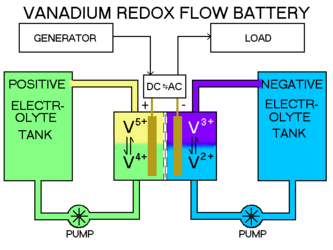http://ift.tt/hZ0OVi
Imergy Power has a new generation of vanadium flow batteries that dramatically lowers the cost and increases the performance and flexibility of energy storage systems for utilities, renewable energy projects, microgrids, and commercial and industrial customers.
The ESP30 series has a power capability of up to 50 kilowatts (kW) and can store up to 200 kilowatt hours (kWh) of electricity. The power and capacity of the ESP30 make it well suited for a variety of demanding energy storage applications, including peak shaving, demand response, energy shifting, renewable energy firming, and microgrid or back-up power.
It is the first battery from Imergy to use secondary sources of vanadium like mining slag, fly ash, and other environmental waste. As a result of this technology and other developments, Imergy will be able to lower the cost of its flow batteries from $500 per kilowatt hour, already an industry benchmark, to under $300 per kilowatt hour.
The ESP30 operates within a far wider temperature range than lithium ion or other storage solutions and is air-cooled. The storage duration can be extended by increasing electrolyte concentration and volume. Built in a modular fashion from replaceable components, the ESP30 has a lifetime that is effectively unlimited.
Vanadium has is a special material with four different oxidation states. A single element can act as a battery so it does not wear out.
Vanadium utility grade batteries could be placed by the feeder stations to enable shifting of the power generated by solar power on homes by four hours. 4 billion kwh of vanadium batteries could be used to enable the intermittent power of solar energy in the USA which is generated at the wrong time for when consumers need to use it to the right time. These batteries can be completely discharged without damage. Lithium ion and other batteries only last a certain number of charge and discharge cycles and cannot be fully discharged without damage.
There is also over a billion tons of Vanadium in the flyash coal waste that has accumulated over decades. 10 kilograms of vanadium is needed for every kwh of battery. So 40 million tons would be needed for 4 billion kwh. If 100 million houses in the USA had 4 kilowatts of solar power, then that would produce a peak of 400 Gigawatts but the energy generation would be at best be for about 6 hours during the day on sunny days.
Imergy's process does not require highly pure Vanadium. They can handle more contaminated vanadium, which is cheaper and easier to get from the flyash.
Read more »

Reposted via Next Big Future
Imergy Power has a new generation of vanadium flow batteries that dramatically lowers the cost and increases the performance and flexibility of energy storage systems for utilities, renewable energy projects, microgrids, and commercial and industrial customers.
The ESP30 series has a power capability of up to 50 kilowatts (kW) and can store up to 200 kilowatt hours (kWh) of electricity. The power and capacity of the ESP30 make it well suited for a variety of demanding energy storage applications, including peak shaving, demand response, energy shifting, renewable energy firming, and microgrid or back-up power.
It is the first battery from Imergy to use secondary sources of vanadium like mining slag, fly ash, and other environmental waste. As a result of this technology and other developments, Imergy will be able to lower the cost of its flow batteries from $500 per kilowatt hour, already an industry benchmark, to under $300 per kilowatt hour.
The ESP30 operates within a far wider temperature range than lithium ion or other storage solutions and is air-cooled. The storage duration can be extended by increasing electrolyte concentration and volume. Built in a modular fashion from replaceable components, the ESP30 has a lifetime that is effectively unlimited.
Vanadium has is a special material with four different oxidation states. A single element can act as a battery so it does not wear out.
Vanadium utility grade batteries could be placed by the feeder stations to enable shifting of the power generated by solar power on homes by four hours. 4 billion kwh of vanadium batteries could be used to enable the intermittent power of solar energy in the USA which is generated at the wrong time for when consumers need to use it to the right time. These batteries can be completely discharged without damage. Lithium ion and other batteries only last a certain number of charge and discharge cycles and cannot be fully discharged without damage.
There is also over a billion tons of Vanadium in the flyash coal waste that has accumulated over decades. 10 kilograms of vanadium is needed for every kwh of battery. So 40 million tons would be needed for 4 billion kwh. If 100 million houses in the USA had 4 kilowatts of solar power, then that would produce a peak of 400 Gigawatts but the energy generation would be at best be for about 6 hours during the day on sunny days.
Imergy's process does not require highly pure Vanadium. They can handle more contaminated vanadium, which is cheaper and easier to get from the flyash.
Read more »
Reposted via Next Big Future

No comments:
Post a Comment